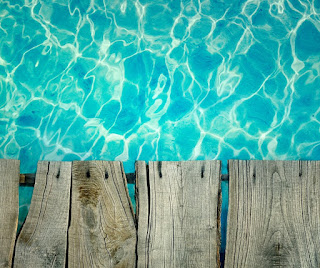The Season of Magic by Naomi Kinsman
Every late spring, my parents used to dare me to jump into our un-heated pool on my birthday--May 20. Now in some cities, the weather has sufficiently warmed up by May 20. However, in Portland, Oregon, we might be talking about a 60 degree day with the water hovering about ten degrees colder. If I braved the freezing plunge, we'd go for ice cream. Thinking back, I should have requested a warmer reward. Hot chocolate, perhaps, or molten lava cake. But, I don't think it was the ice cream that made me bend my knees and leap.
It was the magic.
If you're watching the Olympics, you've seen those underwater shots. Everything is tinted blue-green and the world moves at a different speed. It's a land rich with possibility.
I spent my summers in this magical place, a land filled with mermaids and underwater missions. Once school let out, I slipped into my swimming suit and crossed over into a heroic story. As often as I could, I'd dive into the pool where my unfolding story awaited. The plot twisted and turned. Sharks, villains and other dangers showed up. I needed to find and collect the rings that lay on the bottom of the sea in order to save my mermaid sisters. In the above water world I was an only child, so this quest was urgent and belonged entirely to me.
Submerged in this story, I had no idea that I was training. I wasn't training to be an Olympic swimmer, but rather, to be a writer. To this day, drafting feels like plunging into another world. Sometimes I hesitate on the edge, worried about how the water will feel. Once I let myself go, though, I'm in. I lose myself in the story. If I'm planning, it's not about the next plot point. I'm completely inside my character's skin, strategizing what to do about that shark headed straight for me. When I carry out my plan, what happens next often surprises me.
Maybe I should worry about this multi-player mode that goes on in my artistic mind. But, I actually think this mode is a vital part of the creative process, one that is challenging to tap into and train. While drafting or sketching or improvising, we need to lose ourselves without becoming lost. How do we do that?
As a little girl, even as I dove deeper and deeper into my underwater story, a part of me watched over the entire process. That master storyteller kept working when I finally climbed out of the pool for the day. As we went to the library and walked in the park, she collected ideas and weighed options. She dreamed up and collected an abundance of possibilities so I'd have the opportunity to be surprised. She'd plan the next major plot points and make sure there were plenty of paths by which we might make our way there.
Today, my master storyteller does nearly the same thing. While I'm driving or teaching or wandering through a museum, she collects options. She helps me sketch out a basic map in the form of index cards. And then, she climbs up into the lifeguard chair to watch over me when I dive into my draft. She's there, so it's safe for me to take risks. I can try any crazy new idea that pops into my head--Wait, what if I ... ? She's there to toss in obstacles that keep me from spinning off into an entirely new story. If I climb out of the deep end to find I've made a giant mess, she helps me find my way back.
It's been quite some time since I've thought about the pool and the writerly training it provided. Now, having written about it a bit, I want to ponder it a bit more. As an adult, when I want to develop a skill, I generally work on it in the most obvious medium. If I want to learn to draw, I take out my pencils. Maybe there's something to entering the process through an unexpected doorway. The intangible skills--the ones that are arguably the most essential--might be tapped into much more directly when we approach them sideways.
What do you think?
Naomi Kinsman is the author of the FROM SADIE'S SKETCHBOOK series and recently collaborated with grammy-nominated artist, Natalie Grant on the GLIMMER GIRLS series. Naomi is also the founder and Executive Director of Society of Young Inklings, which offers classes, mentorships and publishing programs for young writers ages 6-16. Naomi crafted WRITERLY PLAY, a game-based approach to creative development that Society of Young Inklings utilizes as the foundation for all of its programming. www.naomikinsman.com

As a non swimmer, a swimming analogy is always compelling to me...and the possibility of an underwater world even more so. Love this "sideways" view of creativity Naomi.
ReplyDeleteWhat a gorgeous post.
ReplyDeleteThanks, Darlene and Claudia! It's not easy to pin creativity down--nor would we want to--so it's always fun to explore ways to come at it sideways.
ReplyDeleteI love this idea of being in two places as you write a story--in the story and watching from afar!
ReplyDelete